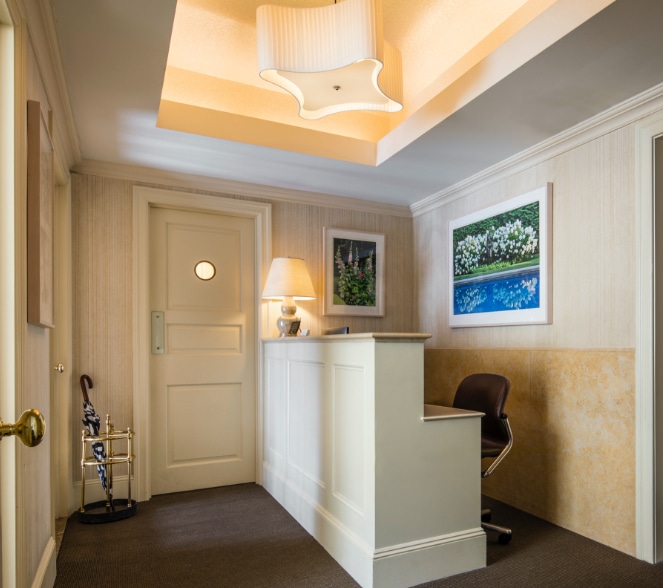What causes gynecomastia?
Most cases of gynecomastia have no specific underlying cause. However, gynecomastia can be caused by testicular and other tumors, although this is rare. There are many drugs that can cause gynecomastia including blood pressure medications, Valium, prostate medications, certain antacids, digitalis, antifungal drugs, chemotherapy agents, and marijuana, among others. Rare congenital disorders such as Klinefelter syndrome can also be responsible for gynecomastia, as can alcohol induced cirrhosis of the liver. Despite these potential contributing factors most cases of gynecomastia do not require a comprehensive work-up prior to treatment.
Most adolescents are driven to seek treatment for gynecomastia because of embarrassment in gym class or at the beach, and older men often because of self consciousness when wearing thin shirts during warm weather outdoor activities. Fortunately most cases of gynecomastia can be effectively treated and the results are permanent.
How is gynecomastia treated?
Gynecomastia is usually treated with a combination of liposuction and direct excision of breast tissue under the nipple area. The incisions are made along the lower half of the areolar circumference at the junction between the dark and light skin. These scars usually fade with time and are rarely conspicuous. Most mature men usually have some hair in this area that further contributes to obscuring the scars. Liposuction consists of injecting the breast area with a dilute anesthetic solution followed by sliding special tubes called cannulas back and forth through the breast tissue to dislodge and then extract the fat. Liposuction removes approximately 80 percent of the excess tissue but removes only the fat. There is also firm glandular breast tissue present that contributes to the condition and is not effectively removed by liposuction. Therefore after completion of the liposuction portion of the procedure the breast tissue is removed by excising it under direct vision through the incision described. The goal is to make the area flat while avoiding aggressive over-resection that could leave a dent. Extreme cases of gynecomastia with hanging breasts may require skin removal in addition to liposuction and tissue excision. The scars are much more significant when this is necessary.
Beyond adolescence beginning in the mid-twenties men will often develop prominent “love handles” around the waist in addition to gynecomastia. These areas can be conveniently treated at the same time with liposuction. The lower abdomen is another area that is commonly treated with liposuction concomitantly. While liposuction can remove bulges due to excess fat in these areas, it does not tighten loose skin. Therefore each patient must be carefully evaluated if liposuction of these other areas is being considered.
Where is the surgery performed and how long does it take?
Surgery is performed in the office as an outpatient and general anesthesia is used. Any specific anesthesia concerns will be reviewed with the anesthesiologist prior to surgery. Most procedures last less than two hours. All surgery is performed entirely by Dr. Hidalgo.
What is the recovery like?
Postoperative pain is typically low grade because surgery involves only the superficial tissues and not deeper structures such as muscle where there tends to be more pain fibers. Oral pain medication is sufficient to control discomfort for the first few days. The chest is wrapped with a wide ace bandage after surgery that is worn for the first week. Moderate swelling does occur but bruising tends to be mild in most cases. It is possible to return to work in a week or sometimes less. Exercise can begin after a few weeks and gradually increase in intensity.
Complications are rare. Bleeding or infection can occur with any surgery but are particularly unusual in gynecomastia surgery. Numbness of the skin in the treated area can occur and this can include the nipple itself. It is possible for numbness to be permanent.
What are some of the limitations associated with surgery?
While every effort is made to make the breast area as flat and smooth as possible, minor irregularities, asymmetry, or residual gynecomastia may become evident months later. If a touch-up procedure is indicated it is usually not performed until one year after the original surgery in order to allow complete healing and softening of the tissues to occur. Most revisions are short procedures that do not cause prolonged swelling, discoloration, or restriction of activities.
What are the costs involved in having surgery?
There are separate fees for surgery, anesthesia, and operating room use. Costs also include preoperative lab tests, medical grade photographs, and support garments.
What are the steps involved in proceeding with surgery?
If you are a good candidate anatomically a surgical date can be scheduled. Photographs and preoperative laboratory studies follow. Older men with significant medical conditions will need to obtain clearance from their internist or other specialist beforehand.




